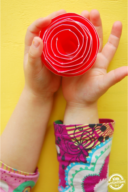We have a really simple balloon and cardboard muscle model that you can make with kids to answer the question, how do muscles work? Kids can learn quickly about the body with this easy muscle model that show how muscles move bones and work with other muscles to stabilize and move joints. Use this muscles for kids lesson at home or in the classroom.

How Do Muscles Work?
There are three types of muscles in the body:
- Smooth muscles that control internal structures like your digestive tract, blood vessels and other things.
- Cardiac muscle that is found in your heart.
- And skeletal muscles which are attached to the bones and create movement which we will explore more today…
Skeletal muscles work when the brain signals the muscle through a motor neuron to contract or shorten. While reading about how muscles work is great, making a hands-on muscle model helps bring the concepts to life.
Elbow Muscle Model Using Balloons & Cardboard Tubes
We are going to show this muscle model as an elbow model, but you could research other joints in the body and make those as well. We will be making three bones: humerus, ulna and radius. We will be making two muscles: biceps and triceps muscle.
Supplies Needed
- 3 cardboard tubes: paper towel rolls, wrapping paper rolls, spool rolls or rolled up cardboard – best if one is larger in diameter than the other 2
- Scissors
- Paper clip, piece of wire or yarn
- Rubber bands
- Tape
- Marker
- 2 Red balloons – long balloon shapes, not round ones
How to Make an Elbow Model with Kids
Step 1 – Build the Bones that the Muscles Attach to

- First identify the bones in your arm
- Humerus – the bone between your shoulder and elbow is a large, long bone that has a larger diameter than the forearm bones
- Ulna – your elbow bone can be felt as the sharp point of your elbow and followed down all the way to your wrist
- Radius – the outside bone of your elbow that can be followed all the way down to the wrist – the radius “rotates” over the ulna bone when twisting your forearm around and back
- Use the biggest cardboard tube to create a humerus bone. If possible, cut it to the approximate size as yours.
- Now make two bones, ulna and radius, that are smaller in diameter and a little shorter in length.
- Use tape to secure the bones if necessary.
2. Step 2 – Make the Elbow Joint

- We used a paper clip by straightening out the paper clip and punching it through the ends of his pieces of bones to connect them, just like an elbow joint would be. You could use a piece of wire or even yarn threaded through the elbow joint.
- We used a rubber band to attach the forearm bones together at the wrist.
- Label the bones with a marker.
Step 3 – Make the Arm Muscles Out of Balloons

- To make the muscles for his model, we used two long red balloons – the skinny ones you use to make balloon animals.
- Blow a balloon up for each muscle…slightly leaving lots of unused balloon on either end.
- Next, tie each of the ends of the balloons to his bones to form the bicep and tricep muscles of his model. You can also use tape to attach the muscle’s origin and insertion:
- Bicep muscle – front of the elbow joint that bends the arm
- Triceps muscle – back of the elbow joint that extends the arm
- Label the muscles with a marker on the balloon
Step 4 – Play with the Muscle Model
See how when the bicep muscle balloon gets shorter (and contracts) it bends the elbow. Watch how when the triceps muscle balloon contracts and gets shorter, it extends the arm.
Our Experience Making a Muscle Model
Nicholas has been learning about the muscles in his body. He’s learned about the tree types of muscles – smooth, skeletal, and cardiac. He is working on learning the names and locations of some of the major skeletal muscles in his body. He created this muscle model and we followed his instructions to make it!
Now he has his own model of a muscle that he can use to demonstrate how the bicep muscle extends when the arm is straight and how the muscle contracts when the forearm is pulled up.
Simple Elbow Bone & Muscle Anatomy Model for Kids

Using balloons and cardboard tubes, kids can build a working model of the elbow to see how muscles work and move joints.
Materials
- 3 cardboard tubes: paper towel rolls, wrapping paper rolls, spool rolls or rolled up cardboard – best if one is larger in diameter than the other 2
- 1 Paper clip, piece of wire or yarn
- 1 Rubber band
- 2 Red balloons – long balloon shapes, not round ones
Tools
- Scissors
- Tape
- Marker
Instructions
- Using the largest cardboard tube, cut a large bone like the one in your upper arm for the humerus.
- Using two smaller diameter cardboard tubes, cut a little shorter length to create the forearm bones, the ulna and radius.
- Using a wire or straightened out paper clip, attach the three "bones" together at the elbow joint.
- Gently blow up two red balloons with just a little air in the middle and attach one to the front of the arm and one to the back of the arm - the front balloon represents the bicep muscle, the back represents the tricep muscle.
- Label all the bones and muscles.
- Watch to see how when a muscle (balloon) contracts or gets smaller it moves the joint.
How do muscles move our bodies?
Kids are experts at asking tough questions. Just like this one! How are bodies work can feel really complicated.
Here is a simple explanation to use with your younger kids to explain how muscles move our bodies:
When we decide to move, our brain sends signals or messages to our muscles. These messages travel through our nerves, like superhighways in our body. When the messages reach our muscles, the muscles receive the signals and start to contract or get shorter. It’s like when you squeeze your hand into a fist. That’s your muscles contracting.
Inside our muscles, there are tiny parts called fibers. These fibers have the special ability to pull on our bones. When the muscles contract, these fibers pull on our bones, making them move. It’s like when you use a string to pull a toy car. The muscles are like the string, and our bones are like the toy car. When the muscles contract, they pull on our bones, and that’s how we can run, jump, play sports, and do all the things we love!
How do muscles get stronger?
Muscles can become stronger when we use them regularly and challenge them in the right way. Try these 50 activities to get moving!
Here’s how it works:
Our muscles are made up of tiny fibers that can get bigger and stronger with exercise. When we do activities that push our muscles, like running, biking, or playing sports, it creates small tears in the muscle fibers. Don’t worry, though, our bodies are smart! After we rest and eat healthy foods, our bodies repair those tears, making the muscles even stronger than before.
As we keep exercising, our muscles adapt to the challenges we give them. They add more fibers and become more efficient at using energy. This makes our muscles grow bigger and stronger over time.
Remember, though, it’s important to start slowly and not push too hard. Our muscles need time to rest and recover between workouts. Eating nutritious foods, like fruits, vegetables, and proteins, also helps muscles grow stronger.
What other activities can I use teach my kids how muscles work?
If you want your kids to explore muscles and movement, get them moving! For example:
- Have them feel their own muscles by flexing their arms or legs.
- Play a game of “Simon Says” where they mimic different movements, emphasizing the use of muscles.
- Encourage physical activities like stretching, jumping, or running to help them experience muscle contractions firsthand.
- Encourage your children to engage in imaginative play where they pretend to be different types of athletes or performers. This can help them understand how different muscles are used for various activities, such as throwing a ball, dancing, or playing an instrument.
Do you have an anatomy model? Use it to point out the relationships between bones, muscles, and movement. Help your kids match the muscles on the skeleton to the muscles in their own bodies.
Looking for more anatomy activities? Check out this kids’ activity about the skeleton. Or this skeleton learning game.
More Anatomy & Science Fun from Kids Activities Blog
- Make a kids heart model
- Help kids learn human bones names
- Download & print our skeleton coloring pages
- Our printable skeleton game helps kids learn the names of bones
- Learn about the live sand dollar and its anatomy!
- Grab our periodic table elements printable
- Egg in vinegar experiment is fascinating
- Let’s play science games
- Scientific method steps for kids…so fun!
- Build a simple atom model
- Try an easy science experiment
- Make the best science project…ever!
How did your elbow joint model turn out? Did your muscles move the arm like you expected?





















SUP